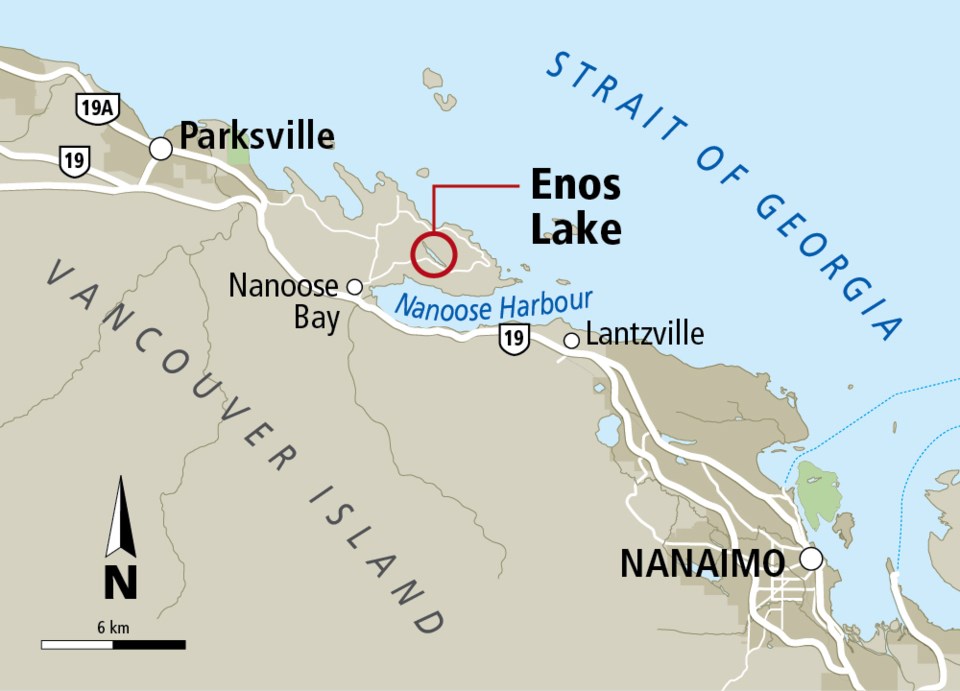Evolution can wipe out a species as surely as pollution, says a biologist who has witnessed and documented the phenomenon in a Vancouver Island lake.
Seth Rudman, a PhD zoology student at the University of British Columbia, has been studying stickleback fish in Enos Lake, a small lake just north of Nanoose Bay, and documenting the evolutionary collapse of two species into one.
“It’s not like what we traditionally think about when we look at extinction, where you just get a drop in numbers until we hit zero,” said Rudman in a telephone interview. “But at the same time, it is a loss of genetic diversity.”

Rudman’s study examined three-spine stickleback, a small freshwater fish that’s about six centimetres long and common throughout coastal B.C. In Enos Lake, the fish had diverged into two distinct populations, with different sizes and habits.
One stickleback subspecies lived closer to shore, in areas filled with aquatic plants, and fed mostly on the aquatic, larval stage of insects. The other was slightly smaller and lived in deeper waters and fed mostly on plankton animals.
But sometime between 1994 and 1997, the signal crayfish, common in mainland B.C. but less so on Vancouver Island, was introduced to Enos Lake.
The introduction of a bottom-feeding scavenger like a crayfish disrupted stickleback breeding and egg rearing, and put a greater strain on the deep-water stickleback.
All stickleback males construct a small nest on the lake bottom at the start of breeding. The male uses colour displays and courtship dances to entice a female to lay her eggs inside.
The male then fertilizes, guards and tends them until they hatch.
Crayfish disturb an egg-sitting male stickleback and even eat the eggs.
Rudman said that while the inshore stickleback tends to build its nest in spots sheltered by aquatic plants, the smaller, deep-water stickleback builds its nest a little more in the open, which makes it easier for foraging crayfish to find them.
Instead of the deep-water stickleback simply becoming extinct, however, the two subspecies started to interbreed, creating a hybrid species.
The hybrid is larger than the deep-water fish and its habits more closely resemble those of the near-shore stickleback — it tends to live close to shore and eat insects instead of plankton.
Since it’s believed the two types, the deep-water and near-shore stickleback, had evolved from a single fish species, the replacement of two with one hybrid species constitutes reverse speciation.
And the effects extend beyond just the stickleback.
“It is also a loss of important species diversity that can affect the whole ecology,” said Rudman.
For example, populations of small plankton animals that were previously eaten by deep-water stickleback have grown.
Effects are even noticeable on land. The new hybrid stickleback prefers to eat larger predatory insects instead of smaller insect larva.
With less predation from both stickleback fish and predatory insects, there has been an increase in numbers of midge-type insects, those that emerge to breed in the air after a larval stage in water.
“So we lost two specialist species through reverse speciation,” said Rudman. “But when that happened, it affected the communities of other organisms and the function of the whole ecosystem.”
Rudman said this loss of species through reverse speciation can be seen even in large animals.
For example, he said, in Africa, the roan and sable antelope are now interbreeding to create a hybrid species.
Rudman said the loss of distinct species is of particular interest in a country like Canada. With glaciers gone from the habitat for only about 12,000 years, Canadian species tend to be “younger” than animals found in other countries.
They have had less time to evolve, become unique and cement their genetics to the point where hybridization is impossible. For example, grizzly bears and polar bears, while distinct species, can still inter-breed.
“A lot of the species we have in Canada are young,” said Rudman. “They are still susceptible to reverse speciation.
“Changes in the environment may see us lose species in ways similar to what is going on in Enos Lake.”
[email protected]



